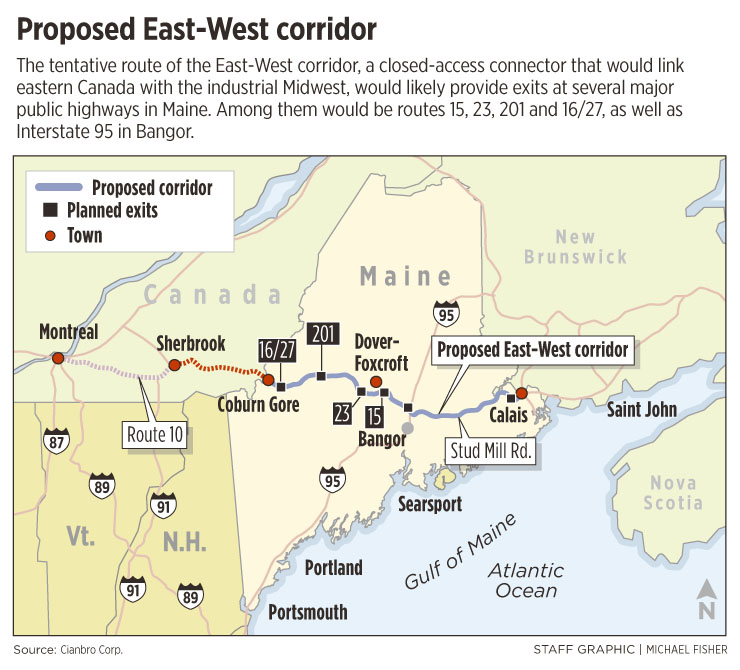PORTLAND — Two Maine environmental groups are calling for more scrutiny and public discussion of the proposed $2 billion east-west corridor.
The Forestry Ecology Network and RESTORE: The North Woods said Monday that the highway across Maine would “disrupt or dislocate” more than 60 conservation lands and designated special places in the northern part of the state.
The corridor, proposed by the Pittsfield-based Cianbro construction company, would have “tremendous impact on Maine’s environment,” said Jonathan Carter, director of the Forest Ecology Network, based in Lexington Township. “It will reduce water and air quality. It is also a threat to Maine’s environment and economy. It’s a … complete environmental nightmare.”
The private toll highway is envisioned to carry predominantly truck traffic across central Maine and connect the Canadian provinces of New Brunswick in the east and Quebec in the west.
Carter said other things could be fit into the 500-foot-wide corridor called for in the road’s design: a natural gas pipeline, transmission lines, bulk water lines or crude oil pipelines.
The Forest Ecology Network and RESTORE: The North Woods, of Hallowell, argued that the planned route of the corridor — which has not been disclosed in detail — would likely have negative effects on at least 63 conservation, recreation and historic sites. The larger areas include:
n The Bigelow Preserve, more than 30,000 acres in Bigelow and Dead River townships.
n The Moosehorn National Wildlife Refuge, more than 28,000 acres of wild land in the easternmost federal refuge on the Atlantic flyway for migrating birds
n Parts of the Appalachian Trail.
The state has allocated $300,000 for a feasibility study of the 220-mile highway from Calais to Coburn Gore. The Legislature is expected to vote next year on the fate of the highway.
Construction is not projected to start for another three years, but the environmentalists said now is the time to ask questions, get details and get proof that the project would be an asset rather than a detriment to Maine’s northern wild lands and the creatures that inhabit them.
Cianbro Chairman and CEO Peter Vigue, who has been promoting the corridor at public meetings in central Maine, has said the highway could transform Maine’s economy by providing a gateway for commerce across eastern Canada.
Supporters say the project could also provide economic opportunities to the rural communities along its route.
Vigue could not be reached for comment Monday.
The feasibility study is expected to be completed early next year. But, Carter said, there is no environmental impact assessment in the study as it is designed.
“We should be having a big discussion about conservation and recreation,” he said. “People need to become educated” and aware of the implications of the proposal for Maine’s prime economic sectors — outdoor recreation, tourism and the opportunity to experience wild places.
“This is Maine’s brand,” he said, and the east-west corridor “will damage the economic benefits” that exist now.
Maine has spent “tens of millions of dollars” in public and private money to protect wild land and special ecosystems in the state, said Jym St. Pierre, Maine director of RESTORE: The North Woods.
Estimating that upwards of $280 million has gone into conservation efforts, St. Pierre said a transportation, utility and communications corridor with a private four-lane highway would devastate Maine’s North Woods.
“It could divide rather than connect ‘the two Maines,’” he said.
Carter and St. Pierre posed a list of questions for the developers and state officials, who they claimed are not providing full disclosure about the cost, methods and impact of the proposal.
They questioned whether the corridor can be built, maintained and patrolled solely with private money, without an ongoing allocation of public funding.
They said alternative transportation — including improvements to existing roads and rail lines — should be investigated before lawmakers vote next year.
“There’s so much big money behind this,” St. Pierre said, underscoring the estimated $2 billion in construction costs. “Maine is just one square on the Monopoly board. We’re all pawns in this big game” that encompasses the interests of energy companies — gas, oil, biomass and wind energy. “We should not be trusting them.”
Staff Writer North Cairn can be contacted at 791-6325 or at:
ncairn@pressherald.com
Send questions/comments to the editors.



Success. Please wait for the page to reload. If the page does not reload within 5 seconds, please refresh the page.
Enter your email and password to access comments.
Hi, to comment on stories you must . This profile is in addition to your subscription and website login.
Already have a commenting profile? .
Invalid username/password.
Please check your email to confirm and complete your registration.
Only subscribers are eligible to post comments. Please subscribe or login first for digital access. Here’s why.
Use the form below to reset your password. When you've submitted your account email, we will send an email with a reset code.